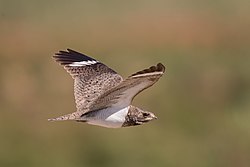| Nacunda nighthawk | |
|---|---|
 | |
| Scientific classification | |
| Kingdom: | Animalia |
| Phylum: | Chordata |
| Class: | Aves |
| Clade: | Strisores |
| Order: | Caprimulgiformes |
| Family: | Caprimulgidae |
| Genus: | Chordeiles |
| Species: | C. nacunda |
| Binomial name | |
| Chordeiles nacunda (Vieillot, 1817) | |
 | |
| Synonyms | |
| |
The nacunda nighthawk (Chordeiles nacunda) is a species of nightjar in the family Caprimulgidae. It is found in Argentina, Bolivia, Brazil, Chile, Colombia, Ecuador, French Guiana, Guyana, Paraguay, Peru, Suriname, Trinidad and Tobago, Uruguay, and Venezuela. Its natural habitats are dry savanna, subtropical or tropical seasonally wet or flooded lowland grassland, and heavily degraded former forest. [1]

